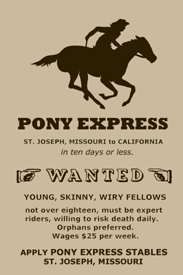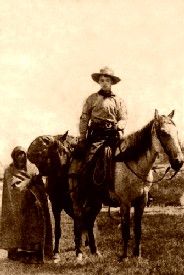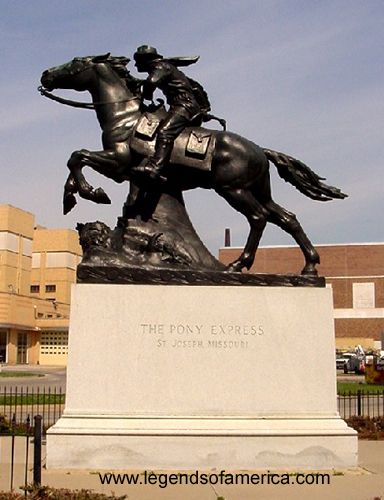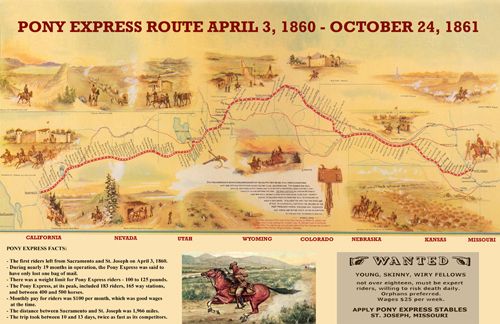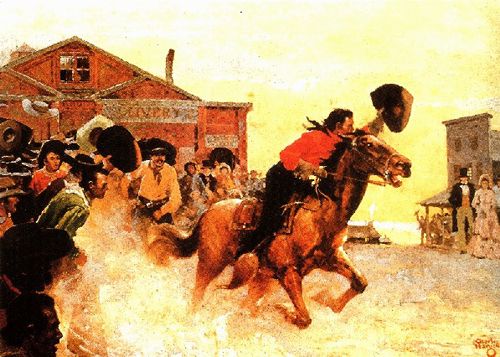
First Ride of the Pony Express
Pony Express History (See Below)
Pony Express Stations Across the American West
Johnny Fry – First Rider of the Pony Express
Pony Bob Haslam & the Longest Ride
Jim Moore – Notable Pony Express Rider & Rancher
“In mid-century America, communication between St. Joseph, on the fringe of western settlement, and gold mining communities of California challenged the bold and made skeptical the timid. Into this picture rode the Pony Express. In rain and in snow, in sleet and in hail over moonlit prairie, down tortuous mountain path.. pounding pony feet knitted together the ragged edges of a rising nation.”
— Frank S. Popplewell
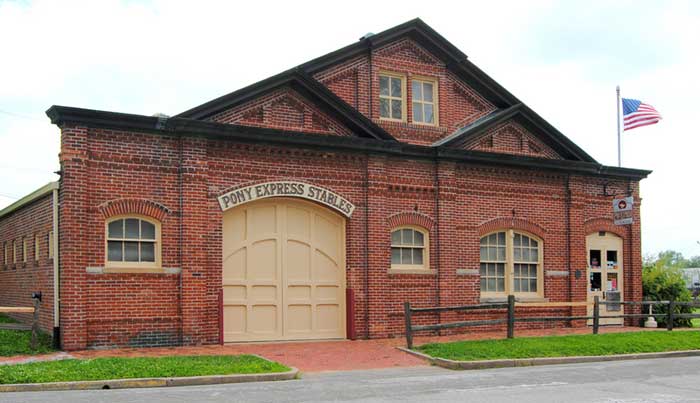
The original Pony Express Stables in St. Joseph, Missouri now serve as a museum. Photo by Kathy Alexander
Pony Express History
The Pony Express was the first “express” mail line across the United States. The outfit began as a “publicity stunt” in hopes of winning a million-dollar government mail contract for Central Overland California and Pike’s Peak Express Company, a freight and stage organization. Owned by William H. Russell, William B. Waddell, and Alexander Majors, the Pony Express became a subsidiary of the larger Central Overland California and Pike’s Peak Express Company. Before the Pony Express, the freight and stage company held government contracts for army supply delivery, employing 4,000 men and owning 3,500 wagons and 40,000 oxen. The Pony Express was born, envisioning a similar contract for fast mail delivery.
From St. Joseph, Missouri, to Sacramento, California, the first successful Pony Express run took place on April 3, 1860. A lone rider on a bay mare galloped from Pike’s Peak Stables in St. Joseph, Missouri, thus inaugurating the famous Pony Express.
Before the advent of the Pony Express, the railroads and telegraph lines extended no further west than St. Joseph, Missouri, and mail traveled west by stagecoach and wagons, a trip that could take months if it arrived at all. The Pony Express alleviated this problem with riders who could dramatically reduce the time it took to deliver the mail. But, it was a dangerous job, fraught with Indian attacks, rough terrain, and severe weather.
The million-dollar mail contract given to Overland Mail Company was almost double the original contract of 1858. It was meant to complete the six-year contract of the southern “Butterfield Route,” which was discontinued in 1861 due to the breakout of the Civil War. Part of Butterfield’s equipment and personnel were transferred to the Central Overland Trail to operate. There was only enough equipment to handle about one-third of the distance to California, so the Pioneer Stage Line was contracted for the western sections and Central Overland California & Pikes Peak Express for the eastern section. Pikes Peak Express stage line, which created the Pony Express, would run into financial problems right away, and the eastern portion was sold off to be operated by Ben Holladay.
During its time, the Pony Express, running in addition to the stage lines, carried mail rapidly overland on horseback for nearly 2000 miles between the Missouri River and the Pacific coast. The mail cost was first $5 per ½ ounce but was later reduced to $1 per ½ ounce. Closely following the Oregon-California Trail, the path diverted south of the Great Salt Lake and headed west across the Sierra Nevada Mountains to save over 100 miles.
Passing through Missouri, Kansas, Nebraska, Colorado, Wyoming, Utah, Nevada, and California, the schedule allowed ten days to cross the plains, deserts, and mountains. The mail was then carried by boat to San Francisco. Though the schedule allowed for ten days, most trips were usually made in eight or nine days, the quickest run occurring in seven days and 17 hours when riders were carrying President Lincoln’s Inaugural Address. This was about 12-14 days shorter than the time required by the Overland Mail Company.
Pony Express riders were usually lightweight young men, often teenagers. For this reason, an 1860 Pony Express advertisement in California read: “Wanted. Young, skinny, wiry fellows not over 18. Must be expert riders, willing to risk death daily. Orphans preferred.” Most of the riders were around 20, but one named Bronco Charlie Miller was only 11, and the oldest rider was in his mid-40s. Most weighed an average of 120 pounds. The Pony Pony Express’s most famous rider was Buffalo Bill Cody. One Hundred eighty-three men rode for the Pony Express, each receiving $100 per month in pay.
However, before they would be hired, they were required to make this oath to the owner and religious man, Alexander Majors:
“While I am the employ of A. Majors, I agree not to use profane language, not to get drunk, not to gamble, not to treat animals cruelly, and not to do anything else that is incompatible with the conduct of a gentleman. And I agree if I violate any of the above conditions, to accept my discharge without any pay for my services.”
Riding in a relay fashion, each rider averaged 10 miles per hour, covering about 75-100 miles before another rider took his place on the route.
Pony Express stations, which eventually numbered somewhere between 150-190, were initially established about 25 miles apart, then increased in number to allow for fresh horses at intervals of 10 to 15 miles. The Pony Express owned about 400 Mustang and Morgan horses, on which the riders traveled.
Special saddlebags that could be moved to a fresh horse quickly at a change station were used. The rider changed to a fresh horse at each station, taking only the mail pouch (called a mochila). The mochila was thrown over the saddle and held in place by the rider’s weight sitting on it. Each corner had a cantina or pocket. Bundles of mail were placed in these cantinas, which were padlocked for safety. The mochila could hold 20 pounds of mail along with the 20 pounds of material carried on the horse, allowing for 165 pounds on the horse’s back. Riders were changed about every 100 miles.
Amazingly, these young riders carried approximately 35,000 pieces of mail over more than 650,000 miles when the Pony Express existed. Further, only one rider lost his life when hostile Indians killed him, and only one sack of mail was lost during this time.
The Pony Express is credited with helping to keep California in the Union by providing rapid communication between the two coasts. News of the election of Abraham Lincoln to the United States presidency in 1860 and of the outbreak of the Civil War in 1861 reached California via the Pony Express.
While the Pony Express dramatically improved the communication between the east and west, it was a financial disaster for its owners. To gain the million-dollar government mail contract, Central Overland California and Pikes Peak Express Company had spent about $700,000, losing about $200,000 of their investment.
When the Pacific Telegraph Company completed its line to San Francisco in October 1861, it would spell the end of the Pony Express.
The Pony Express marked the highest development in overland travel before the coming of the transcontinental railroad, which it preceded by nine years. It proved the feasibility of a transcontinental road and demonstrated that such a line could be built and operated continuously the year around – a feat that had previously been regarded as impossible.
Today, the Pony Express Headquarters and the Pony Express Stables still stand in St. Joseph, Missouri, serving as two different museums.
The Pony Express National Museum in St. Joseph, Missouri, displays educational, state of the art exhibits conveying the need, creation, operation, and termination of the Pony Express. Whatever your age, you’re sure to be captivated by the stories and images of an era long passed.
Contact Information:
Pony Express National Museum
914 Penn Street
St. Joseph, Missouri 64503
800-530-5930/816-279-5059
© Kathy Alexander/Legends of America, updated June 2022.
Also See:
Central Overland California and Pike’s Peak Express Company
John Butterfield & the Overland Mail Company
Russell, Majors & Waddell – Transportation in the Old West
Tales & Trails of the American West

